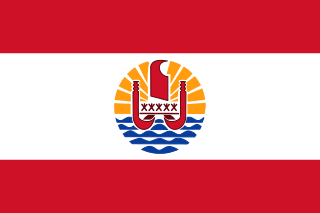
French Polynesia is an overseas collectivity of France and its sole overseas country. It comprises 121 geographically dispersed islands and atolls stretching over more than 2,000 kilometres (1,200 mi) in the South Pacific Ocean. The total land area of French Polynesia is 3,521 square kilometres (1,359 sq mi), with a population of 278,786 of which at least 205,000 live in the Society Islands and the remaining population lives in the rest of the archipelago.

The economy of French Polynesia is one of a developed country with a service sector accounting for 75%. French Polynesia's GDP per capita is around $22,000, one of the highest in the Pacific region.
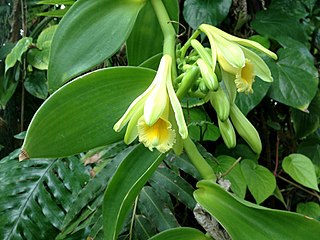
Vanilla is a spice derived from orchids of the genus Vanilla, primarily obtained from pods of the flat-leaved vanilla (V. planifolia).
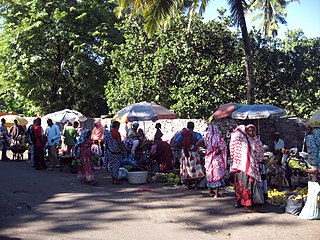
The economy of the Comoros is based on subsistence agriculture and fishing. Comoros has inadequate transportation links, a young and rapidly increasing population, and few natural resources. The low educational level of the labor force contributes to a subsistence level of economic activity, high unemployment, and a heavy dependence on foreign grants and technical assistance. The Comoros, with an estimated gross domestic product (GDP) per capita income of about $700, is among the world's poorest and least developed nations. Although the quality of the land differs from island to island, most of the widespread lava-encrusted soil formations are unsuited to agriculture. As a result, most of the inhabitants make their living from subsistence agriculture and fishing. Average wages in 2007 hover around $3–4 per day.

Tahiti is the largest island of the Windward group of the Society Islands in French Polynesia. It is located in the central part of the Pacific Ocean and the nearest major landmass is Australia. Divided into two parts, Tahiti Nui and Tahiti Iti, the island was formed from volcanic activity; it is high and mountainous with surrounding coral reefs. Its population was 189,517 in 2017, making it by far the most populous island in French Polynesia and accounting for 68.7% of its total population; the 2022 Census recorded a population of 191,779.

Vanillin is an organic compound with the molecular formula C8H8O3. It is a phenolic aldehyde. Its functional groups include aldehyde, hydroxyl, and ether. It is the primary component of the extract of the vanilla bean. Synthetic vanillin is now used more often than natural vanilla extract as a flavoring in foods, beverages, and pharmaceuticals.

Huahine is an island located among the Society Islands, in French Polynesia, an overseas territory of France in the South Pacific Ocean. It is part of the Leeward Islands group (Îles sous le Vent). At the 2022 census it had a population of 6,263.

Raʻiātea or Raiatea is the second largest of the Society Islands, after Tahiti, in French Polynesia, in the South Pacific Ocean. The island is widely regarded as the "centre" of the eastern islands in ancient Polynesia and it is likely that the organised migrations to the Hawaiian Islands, and other parts of East Polynesia started at Raʻiātea.

Tahaʻa is an island located among the western group, the Leeward Islands, of the Society Islands in French Polynesia, an overseas territory of France in the South Pacific Ocean. The islands of Tahaʻa and neighboring Raiatea to the immediate south are enclosed by the same coral reef, and they may once have been a single island. At the 2022 census it had a population of 5,296. The island has an area of 90 square kilometres. Mount Ohiri is the highest mountain on the island standing at 590 metres (1,940 ft) above sea level. It is also known as the "Vanilla Island" and produces pearls of exceptional quality.

Vanilla extract is a solution made by macerating and percolating vanilla pods in a solution of ethanol and water. It is considered an essential ingredient in many Western desserts, especially baked goods like cakes, cookies, brownies, and cupcakes, as well as custards, ice creams, and puddings. Although its primary flavor compound is vanillin, pure vanilla extract contains several hundred additional flavor compounds, which are responsible for its complex, deep flavor. By contrast, artificial vanilla flavor is solely made up of artificially derived vanillin, which is frequently made from a by-product of the wood pulp industry. Because of the way that vanilla extract is made, there is no possible way for it to be colorless or clear. Therefore, any clear vanilla flavoring is artificial.

Vanilla, the vanilla orchids, forms a flowering plant genus of about 110 species in the orchid family (Orchidaceae). This evergreen genus occurs worldwide in tropical and subtropical regions, from tropical America to tropical Asia, New Guinea and West Africa. Five species are known from the contiguous United States, all limited to southern Florida.

The Leeward Islands are the western part of the Society Islands in French Polynesia, an overseas collectivity of France, in the South Pacific Ocean. They lie south of the Line Islands, east of the Cooks and north of the Austral Islands. Their area is around 404 km2 (156 sq mi) and their population is over 36,000.
Domesticated plants of Mesoamerica, established by agricultural developments and practices over several thousand years of pre-Columbian history, include maize and capsicum. A list of Mesoamerican cultivars and staples:
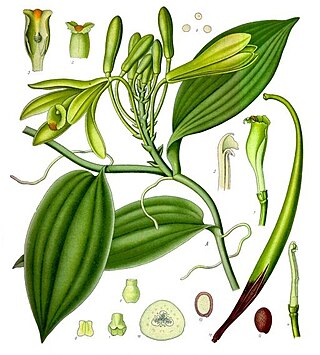
Vanilla planifolia is a species of vanilla orchid native to Mexico, Central America, Colombia, and Brazil. It is one of the primary sources for vanilla flavouring, due to its high vanillin content. Common names include flat-leaved vanilla, and West Indian vanilla. Often, it is simply referred to as "the vanilla," or just vanilla. It was first scientifically named in 1808. With the species' population in decline and its habitats being converted to other purposes, the IUCN has assessed Vanilla planifolia as Endangered.

Agriculture employs the majority of Madagascar's population. Mainly involving smallholders, agriculture has seen different levels of state organisation, shifting from state control to a liberalized sector.

This page list topics related to French Polynesia.

The Tahitian pearl is an organic gem formed from the black lip oyster. These pearls derive their name from the fact that they are primarily cultivated around the islands of French Polynesia, around Tahiti.

Vanilla × tahitensis is a hybrid orchid in the genus Vanilla. It was first described by the botanist John William Moore in 1933 from Raiatea in the Society Islands, where it was found growing on trees, having escaped from cultivation.
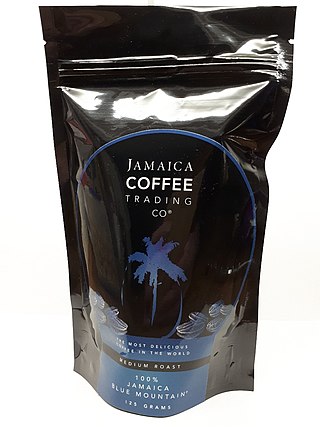
Coffee production in Jamaica began after 1728, when governor Sir Nicholas Lawes introduced the crop near Castleton, north of Kingston. Jamaican Blue Mountain Coffee is the special variety of coffee that is grown in the Blue Mountains region, which has the most conducive climate and topographical features; this variety is known for its scent and sweet taste. Most of Jamaica's coffee production is grown for export.

Vanilla odorata, also known as vanilla tlatepusco, is a species of flowering plant in the family Orchidaceae, native to southern Mexico, Central America, and tropical South America. With Vanilla planifolia it is a parent of the vanilla crop species Vanilla × tahitensis.






















